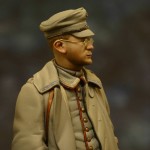
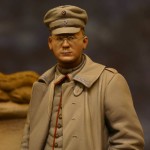
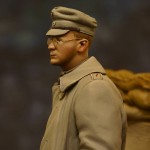
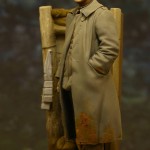
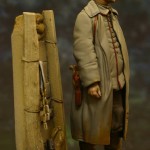
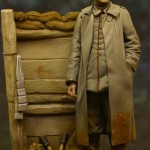
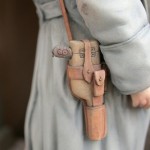
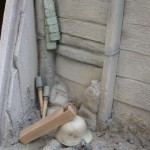
Infantry NCO, Western Front 1917 with Trench Section
- Scale / Maßstab: 1:16
- Approx. height of figure: 115mm
- Material: Resin (figure), Acryl Glass (Plexi – glasses), Plastic Mirrors, Model Plaster (base)/ Resin, Acrylglas, Kunststoff-Spiegel, Modell-Gips Sockel (synethetische, kunststoffveredelte Gießmasse)
- Parts / Teile: 24
- Infosheet / Infoblatt: English
- Code: 22MXN
Contents / Inhalt:
- Figure (5 parts) / Figur (5 Teile)
- 2 x Spectacles (Acryl Glass) / 2 Stck. Plexi-Brillen
- Mauser C96 Pistol / Mauser C96 Pistole
- Bandolier
- Trench Periscope (4 parts) / Graben-Periskop (4 Teile)
- 2 x Stick Grenade / 2 Stck. Stielhandgranate M.15
- Egg Grenades / Eihandgrenate M.17
- Steel Helmet / Stahlhelm M.16
- Empty Ammunition Cases / Leere Patronenhülsen
In Model Plaster / Modell-Gips:
- Trench Duckboards (Base) / Grabenboden (Sockel)
- Trench Wall / Grabenwand
- 2 x Sandbags / 2 Stck. Sandsäcke
Extracts from the Infosheet with this figure:
The figure depicts an NCO serving with an infantry unit stationed within the Front Line area during the winter 1917/18. This is not the forward front line, but a support trench further to the rear of the main position.
The original idea for this figure came from a group photo of German Kraftfahrtruppen, or transport troops, posing around some vehicles. Apart from the absence of the ankle boots and changes to the collar, this is a near as possible reproduction of this soldier. Although the original photo is quite clear, it is still not apparent with the fall of light and shadow if he is wearing spectacles or not. The Mauser C96 pistol was added slung casually over the left shoulder as if only coming out of the dugout for a breath of fresh air.
The German Soldier of 1917 and 1918. The German soldier in 1917/18 had changed somewhat from his comrades of 1914. Firstly, he would have been much younger – on average about 18/19 years of age after finishing training – NCOs a year or two older. The style of his uniform differed not only in quality but functionality as well, with many items of clothing and equipment produced in Ersatz material, or a combination of mixed dress. Infantry Companies within the Front Line areas numbered on averaged 75 – 80 soldiers, some as low as 50 (a full Company strength would be around 135 men), with the bulk of its fighting capacity and experience held by only 15 – 20 old sweats. As the war progressed more emphasis was put onto automatic weapons and as many as 4 MG 08/15s per Infantry Company were issued.
NCO / Officers Field Cap M1917 / Einheitsfeldmütze M1917: This is the later version of the grey NCO / Officers Field Cap. There were in fact many different types and forms of the Field Cap, both privately purchased and official issued items. In order to simplify production on account of shortage of natural materials, especially leather it was decided to leave out many of the pre-war characteristics in later types. From spring 1917 onwards the peak and chinstrap were no longer made from leather, but an Ersatz material, either vulcanised fibre or treated card, both finished in a matt grey tone. I have chosen to model an old type black leather chinstrap to give this otherwise grey in grey field cap some coloured contrast. The chinstrap at each side had either black metal (old type) or grey buttons. The coloured band and piping were from mid 1917 also officially issued in grey, although some caps were produced with band and piping in resedagrün, or mignonette (Reseda), a type of greyish-green. Of cause these resedagrün caps were sought after and officers and NCOs valued the slight difference in appearance. The two metal Kokarden badges at the front were – top: Die Reichsfarben: black, white and red (from outwards to the centre) and – bottom: Kokarde representing the state where the Unit was raised – e.g. Prussia – Preussen: black, white and black. Bavaria – Bayern: white, light blue and white. Brunswick – Braunschweig: blue, yellow and blue. Hessen – Hessen: white, red and white etc.
Field Service Dress Tunic M1907/10 / Feldrock M1907/10: Underneath the greatcoat he wears the Field Service Dress Tunic M1907/10. This was the main field service dress issued to all foot troops during the first years of the war. It had depending on the unit or home state different variations of cuff and skirt design. Colour: made out of a dark grey material (Jäger, Maschinengewehr and Schützen units wore sometimes a green- grey version). It had a turn down collar, with eight nickel or Tombak (Tombak: an alloy of copper and zinc, which had a matt bronze/yellow colour) buttons at the front. Although hidden underneath the greatcoat, the shoulder straps for infantry regiments were piped (outlined) in white, with the monogram, or number in red. Red piping also appeared along the front of the tunic, where the buttons lie, the outside edge of collar, skirt decorations at the rear and the cuffs. On the collar is the gold coloured Unteroffizierstresse, or NCOs braid.
Mauser C96 Pistol / Mauser Pistole C96: At the outbreak of hostilities the 08 Luger Pistol long barrel version (Luger the Germans never called this weapon the Luger – this is an anglicised name) could not be issued quickly enough to artillery and auxiliary units, so the German Army purchased a large number of C96s, which also had the extended wooden butt. Although originally put through trials 1 year before the war, the C96 was not taken on. The calibre is 7.63, with a 10 round capacity in the magazine, which was later changed by the Mauser Company in 1916 to the standard 9mm. In order to avoid mix-ups with different ammunition, a figure 9 was carved into the pistol grip and painted out in red. The tool on the side of the leather holster is the cleaning rod with a wooden handle. The small pocket at the front holds a spare ammunition strip. Normally, the pistol is carried attached to the belt, on the left hand side. A sling was also supplied to enable the person to wear the pistol over the left shoulder with the weapon resting on the right hip.
Although originally intended for issue to artillery units these pistols found their way into many other parts of the army and were particularly popular with soldiers and NCOs serving in the front line units (officers would normally have smaller pistols). Also, these pistols were well liked with Stormtrooper units for their reliability and robustness. Colour: leather supporting rig – natural leather, wooden shoulder stock/holster – brown wood, gunmetal – dark metal colour.
Note: the small ring attached to the bottom of the pistol grip can be hollowed out.
Field Grey Overcoat M1915 / Einheitsmantel M1915: The standardized field grey coat M1915 for all ranks (including officers) was to replace all other types in service at the time for both mounted and dismounted soldiers in the German Army. The coat was to be more practical for front line service, enabling extra freedom of movement and make officers and other ranks appear alike. Front line experience showed that troops needed good protection against the elements and the extensive cut of the coat enabled the wearer, particularly in cold conditions to add extra garments underneath. In addition, during off duty hours the soldier could rap himself up within the coat.
The length of the coat was to half way up the calf muscle; the turned back sleeves should cover the hands up to the knuckles. In the above centre part of the back was a large fold, which started at the collar and ended at the waste band belt. The lower part of the rear was split in two, started just below the waste belt and was held together by 4 horn buttons. If an equipment belt was worn with the coat then the waste belt should be visible below. For mounted and marching troops the front 2 coat flaps could be turned outwards and fixed to the sides (more commonly seen with French troops of this period). The wide reed-green turned down collar (field-grey with Bavarian units) could be buttoned up either under the chin or with a second fastener hook over the mouth. In front is a row of 6 Tombak or nickel buttons (later on account of shortages – steel) the last button should be below the waistline (or belt). At each side were 2 large pockets with flaps.
Infantry Boots M1866 / Infanteristiefel M1866: The nailed infantry boots for other ranks were made out of leather and had a tendency to `winkle´ down around the ankles after being worn in. Depending on size they had between 35 and 45 nails in the sole and reinforced heel. On each side of the boot shaft are seams where the front and rear of the leather are joined together. Colour: at the beginning of the war the boots had a natural light tan, which was then often darkened by coats of dubbin. As per Army regulation September 1915, boots (and much of the other leather equipment as well) were issued in blackened leather.
 An deutschsprachige Interessenten:
Sie können mich per eMail oder Telefon auch gerne auf deutsch kontaktieren. Ortsbesuch ist nach Absprache möglich.
An deutschsprachige Interessenten:
Sie können mich per eMail oder Telefon auch gerne auf deutsch kontaktieren. Ortsbesuch ist nach Absprache möglich.
